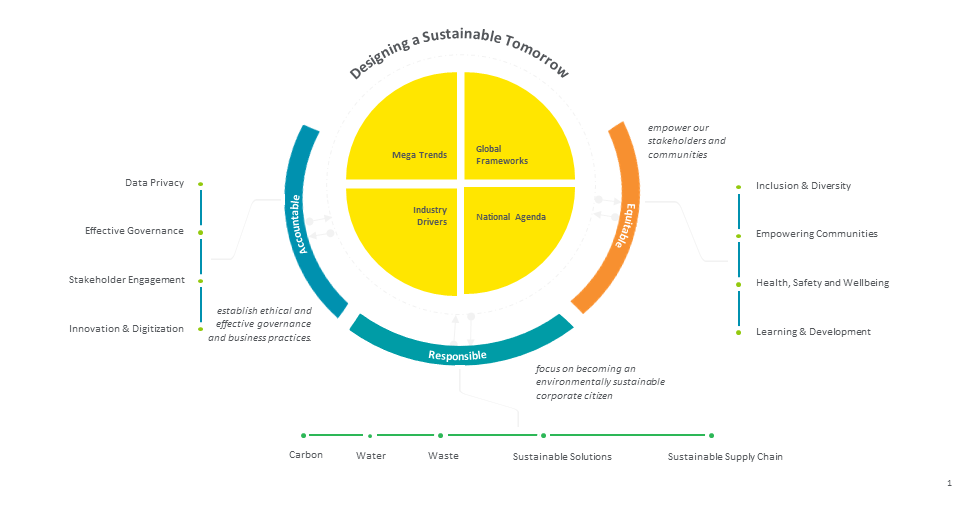Driving sustainability through technology and reinforcing responsibility among organizations
Written by Cyient 29 Apr, 2022
As we approach Earth Day on April 22nd, it is a good time to revisit the idea of sustainability and ESG (Environmental, Social and Corporate Governance). Increasingly corporations are focusing on sustainability becoming a key operative in their business. Companies are socially conscious about sharing the future with generations to come and are making ethical choices across their manufacturing, R&D, distributions, supply chain among other facets of operations. The importance of sustainability has been discussed across several forums, and industry experts are all in agreement, sustainability is a crucial part of overall business strategy. While an investment in sustainability might seem like an additional overhead, experts suggest organizations with sustainability strategies incorporated in their business plan are often the most profitable.
While the need to move to a more sustainable tomorrow is imminent, there are underlying challenges that are often impediments to the journey. The sustainability narrative requires a strong shift in the business strategy, that allows all stakeholders to understand that there is a movement from risk to opportunity. The overall transition to sustainability is a journey as well and requires operationalization at each level to ensure the successful management of the sustainability strategy.
On April 20th, Cyient hosted a webinar with five industry experts who shared their views on how technology, sustainability and ESG are playing a larger role in building a better tomorrow. The discussion was opened by Katie Cook, who emphasized on the importance of ESG and how a solid framework was the key to becoming accountable, responsible, and equitable. A holistic framework addresses everything from data privacy, ensuring the privacy of associates, stakeholders, customers and having an effective governance mechanism across the board. A good governance framework also tackles feedback seriously, from associates, customers or even shareholders.

Cyient’s ESG Framework
At Cyient, sustainability plays a critical role in how our business engages with customers and stakeholders. Our sustainability framework is based on designing a better tomorrow and fosters our commitment to a circular economy. We believe that, along with good governance, sustainability also plays a key role in organizational accountability. It is important for organizations to align with the United Nations Sustainable Development Goals by ensuring the ability to tap into solar and other renewable forms of energy. Being equitable is equally important, with values in the company ensuring they have equal pay, equal opportunities and that they are giving back to the communities in which they serve.
Four industry experts from Cyient shared their views on how the interplay of technology and sustainability could deliver the promise of a better tomorrow. Anthony Walker addressed the impact of Mining as an industry and its impact on the environment. The mining industry is making significant efforts to move towards its ESG ambitions and making investments to ensure they can build stronger relationships with indigenous communities. The industry is learning from disasters such as the Brumadinho dam burst in Brazil, to course correct its role in environmental impact. Using this example, he was able to showcase how Cyient ‘s technology can be used to avert such a crisis and create a demonstrable impact in the M&R industry.
The automotive industry is one where sustainability has begun to demonstrate itself significantly. Even today, while the assembly line manufacturing process continues to use large amounts of plastic, metals, and energy, when it comes to powering the automobile, sustainability plays a crucial role. This is especially relevant as electric vehicles gain more popularity. Companies like Ford and Volvo have pledged to go fully electric in the next few years. Sravan Kumar addressed how electric vehicles pollute significantly lower than vehicles powered by an Internal Combustion Engine (ICE) that uses conventional fuels. Moving to electric vehicles has a strong impact on the environment, lowering CO2 levels by 30-40% as well as greenhouse emissions. Efforts like battery recycling have a strong, positive impact on the environment.
Speaking about emissions from the supply chain perspective, Sreejith Sreedharan brought the concept of scope one and scope two emissions, which are emissions which you are a direct contributor of and emissions your suppliers or vendors may be a direct contributor of. Long tail of the supply chain is also a massive contributor of emissions. Long tail entails items like paper and other packaging material contribute to Scope three of emissions. He emphasized on how individuals' actions as buyers of a product have a direct impact on sustainability and lowering the carbon footprint, when there is a global demand that manufacturers and suppliers maintain their emissions below a certain threshold.
Sustainability and obsolescence management are closely linked as well. Chakor Ukarde introduced the need for a mechanism where products or parts that may not be available in future do not cause obsolescence for the entire product line. There are ready tools available today, where a bill of material of all the parts can be uploaded and the tool provides information on which parts would get obsolete in the next few years. Notifications from these tools play a crucial role in addressing the obsolescence of the product. The ability to repair and redesign the product also plays an important role in ensuring sustainability by mitigating obsolescence. Organizations with a large product line can also explore cannibalization, where the inventory of products they have can be used for products which are obsolete.
Building a sustainable future is imperative. The need for organizations to rethink their strategy begins with looking through their own operations and understanding bottlenecks that hamper overall sustainability. At Cyient, sustainability is paramount to the way we operate and our overall vision, and it is one of the five Megatrends we are focusing on. Initiatives such as Design for Circularity are focused on creating new products and technologies with sustainable development at the forefront of all our engagements. If you would like to know more about Cyient and our views on sustainability, you can visit: https://www.cyient.com/about-us/sustainability
.png?width=774&height=812&name=Master%20final%201%20(1).png)